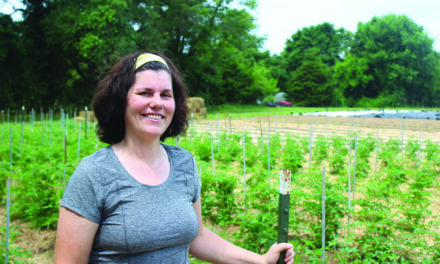
Black oil sunflower seeds are high on the list of many bird species searching for food in the winter. Some birds prefer to feed on the ground, whereas others prefer to dine from a feeder. (Photo by Dave Burgevin)
With a minimal investment and a little planning, you can experience the joy and wonder of backyard birding. And what better time of year than winter.
A carefully placed feeder can provide hours of enjoyment for the whole family, all from the comfort of your home.
What kinds of birds are commonly found in backyards in the Mid-Shore region this time of year?
Bettye Maki, president of the Talbot Bird Club, listed the following: cardinals, housefinches, junkos, white-throated sparrows, house sparrows, titmouses, bluejays, and goldfinches.
Each variety has their own unique color plumage and personality. But what do you feed our feathered friends, and where?
Maki highly recommends black oil sunflower seeds fed either on the ground (such as on a patio) or a feeder, depending on the variety of bird you are trying to attract.
Some birds prefer to feed on the ground, whereas others prefer to dine from a feeder.
Homeowners should also be mindful of the size of the birds they are feeding when choosing a feeder.
Be sure your feeder has feeding ports large enough for larger varieties of birds to access the feed.
Cracked corn can also be helpful to wild birds this time of year, as the extra protein and fiber can help them keep warm.
Additionally, whole, shelled or crushed peanuts are a special treat for birds of every size. However, be sure to purchase these peanuts from a bird supply store or feed store to be sure they are free of salt, flavorings and contaminants.
A local resource for feed, advice and products is Wild Birds Unlimited in Easton. Its staff is certified bird feeding specialists vetted by such organizations as the Arbor Day Foundation, the National Wildlife Federation, The Hummingbird Society, and the Cornell Lab of Ornithology.
“Brush piles, shrubs like yews and hollies, and roosting pouches all give birds a place to get out of the weather and make it through those cold nights,” said store owner, Rhonda Matterson.
She added feeding high-fat food is critical, since birds can lose up to 10 percent of their body weight on cold nights.
“Imagine a 200-pound person losing 20 pounds overnight. That is a lot!” she said, offering perspective.
Along with quality, specialized bird feed and roosting pouches, Wild Birds Unlimited sells a wide variety of other products for backyard birders.
“That’s what we’re here for, to help educate,” Matterson said emphatically.
Looking for an activity to do with your children that is fun, a little messy, and will help them grow their love for the natural world?
Make pinecone bird feeders! Or, if you do not happen to have a pinecone connection, you can also use toilet paper tubes instead.
Coat in Bark Butter or suet, roll in bird seed, and hang from a branch with a piece of twine.
Regardless of whether your feeder is store bought or homemade, placement is key.
Maki recommends placing it either close (3 feet) or far (at least 20 feet) away from windows.
This is to help provide the safest conditions possible for birds to be able to land on a feeder or take off to avoid a predator without striking a window.
While many people put their bird baths away at the end of summer, it could be argued that the birds need them in the winter most of all.
A source of fresh, clean water for drinking and bathing is critical to the health of wild birds.
A birdbath heater with an automatic thermostat will keep the water from freezing.
When word gets out among the birdie-community that a well-tended bird spa is in your yard, you are going to have a ball watching scores of them splish-splash!
If you desire to learn more about birds and make some new friends, consider joining your local birding club.
The Maryland Ornithological Society is a non-profit organization dedicated to the appreciation and conservation of wild birds.
It’s website, www.mos.org, has a section titled ‘Chapters’ that lists all the chapters in Maryland.
For example, Maki’s chapter, The Talbot Bird Club has over 130 members and meets at the YMCA most months and goes on regular bird walks both near and far.
“We go where the birds are,” Maki said simply.




